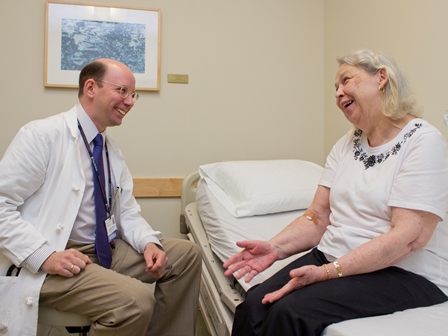 Lois Hahn couldn’t have been happier on Tuesday. The 71-year-old wife and grandmother was back at Penn’s Abramson Cancer Center, with her son and husband by her side, for a follow-up visit with her medical oncologist, Alexander Perl, MD, an assistant professor of Hematology/Oncology in the ACC. She’s feeling and looking great. ”I’ve been in remission for months,” she said. “I’m almost back to my old self.”
Lois Hahn couldn’t have been happier on Tuesday. The 71-year-old wife and grandmother was back at Penn’s Abramson Cancer Center, with her son and husband by her side, for a follow-up visit with her medical oncologist, Alexander Perl, MD, an assistant professor of Hematology/Oncology in the ACC. She’s feeling and looking great. ”I’ve been in remission for months,” she said. “I’m almost back to my old self.”
Just six months ago, though, the acute myeloid leukemia (AML) patient found herself in a very different situation. “I was told I only had a few weeks to live,” she said. While most AML patients do well on chemotherapy and go into remission, some fail to respond and often die within months of being diagnosed. But Hahn’s story is playing out differently.
Not long after hearing the devastating news, Hahn’s son Ed found out about a clinical trial investigating a promising targeted drug, this one for patients with the mutation known as FLT3, led by Perl. Because the majority of patients with this mutation either don’t respond to initial chemotherapy or relapse after achieving remission, the search—including the one at Penn—for better, targeted drugs continues on.
Hahn, whose leukemia mutation was sequenced at Penn’s Center for Personalized Diagnostics, qualified for the trial after her chemo failed (a prerequisite since the trial was for patients who failed therapies or who relapsed) and was enrolled shortly thereafter. Like nearly 50 percent of the people in the trial with the mutation, Hahn had a complete response. The results were dramatic—she responded really well and really quickly and has been cancer free for five months. “It did wonders for me,” said the Egg Harbor Township, N.J., resident.
The oral drug, called ASP2215 from Astellas, is an inhibitor of FLT3, the mutated gene sometimes referred to as the “relapse gene” that signals bone marrow stem cells to divide and keep replenishing. The drug clears leukemia cells from the blood and keeps leukemia cells in the marrow from dividing, while replenishing the blood with healthy cells.
“FLT3 mutations hijack the normal way that the bone marrow regulates the number of blood cells to produce—it essentially it creates a response without a stimulus,” Perl said. “I liken it to a light bulb that stays on even when you try to turn off its switch on the wall. Or if the gas pedal in your car has been glued to the floor: the car moves forward whether the driver wants it to or not. What FLT3 inhibitors do is starve the engine of its fuel.”
For the trial, almost 200 patients were enrolled (127 with the FLT3 mutation) from across the country and Western Europe. Over 57 percent of those with the mutation had an overall response, while 47 percent of them had a complete remission, including Hahn, the research team found. Very few, if any, patients responded if they didn’t have FLT3 mutations.
Identifying mutations in the age of precision medicine isn’t the biggest challenge anymore; it’s knowing how to act on them and demonstrating successful outcomes.
“This is an exciting new therapeutic development for patients with relapsed or aggressive cancers that fail to respond durably to chemo,” said Perl, who presented the study’s results two weeks ago in Vienna, Austria at the 20th Congress of the European Hematology Association meeting. “There is a unmet need here, and this well-tolerated drug demonstrated very high response rates and often more durable responses. What we have are promising data that push us steps closer to a new therapeutic option for this underserved population.”
Clinical trials with other FLT3 inhibitors have been ongoing for more than 10 years, but until recently the class of drugs has either shown less obvious clinical activity or concerns about early development of resistance among responding patients. Perl was involved in the research that characterized the mechanism of FLT3 inhibitor resistance, which was published in the journal Nature in 2012. This latest round of results—the ASP2215 first in-human study—were from a phase I/II, laying the groundwork for a phase III trial set to open later in 2015.
“Dr. Perl asked me what my goals were before starting this, and I told him I wanted to play with my grandkids,” Hahn said. “And that's what this drug did.”